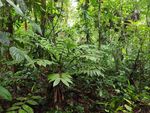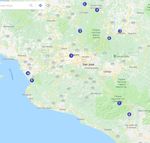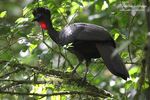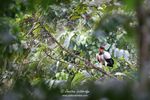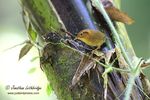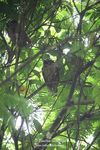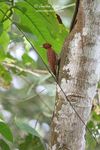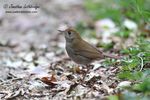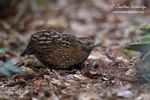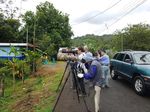COSTA RICA, MARCH 2018 - CloudBirders
←
→
Page content transcription
If your browser does not render page correctly, please read the page content below
COSTA RICA, MARCH 2018
In early March 2018 my fellow patch-worker Bob V and I spent an entire week in Costa Rica. This
is by far and away the longest bird trip I have ever been on and I mean that entirely seriously.
Most trips to this country however last a fortnight, time I am not able to take, and as such we
reduced the number of distinct areas we went to and also reduced the typical amount of time that
is spent in each of these areas. If we missed something there were limited opportunities to try
again. Despite the compressed timetable it was utterly fantastic and by some margin the best
place I have ever been birding. We missed very little and notched up 414 species in 6.5 days, not
far off the totals expected on the longer itineraries, and what's more had a lot of fun doing it. The
Tropics are simply incomparable
Logistics
We opted on a fully guided trip - rain forest birding in a country with the diversity of Costa
Rica is incredibly difficult and we wanted to maximise what we saw.
We used 'Costa Rica Gateway' to create a bespoke itinerary for us, focusing on seeing as
many of the near-endemics as possible in the allotted time. Kevin Easley runs CRG and
proved to be excellent.
The cost was approximately £1550 per person and included a guide, a vehicle and all fuel,
seven nights accommodation, most meals, and all reserve entrance fees.
We spent barely anything else during the week- a few cheap lunches, some evening beer
and a tip for our guide.
Travel was with BA was an easy choice as they have four direct flights to San José from
Gatwick every week. Prior to this option flights were via Madrid or the USA. We left on
Saturday morning, returning the following Saturday afternoon.
No visas were required for UK citizens.
The local currency is Colones but US Dollars are widely accepted.
Mosquito repellent is a must but the bugs were not as bad as you might think.
It was hot in the lowlands and a bit cooler in the highlands - a mix of clothing is needed, as
well as waterproof shoes and a raincoat for some areas.
We took the Birds of Costa Rica (Richard Garrigues and Robert Dean). This was wholly
unnecessary as our guide was Leonardo Garrigues. The clue is in the name....he was
unbelievable.
Leo came with a scope so there was no need to bring one. I took my camera instead but
birding always came first. Blink and you'll miss it.Lesser Violetear Itinerary The itinerary was a tried and tested one - two days each in the Caribbean Lowlands, Highlands and Pacific Lowlands, with some time devoted to travelling between the areas. The reserves and areas visited appear on many if not all trips reports, as indeed did all of the hotels, and are chosen for good reason - they were all exceptional. Each birding location had a different mix of birds. Day 1: Flight to SJO, arriving early afternoon. Met at the airport for hotel transfer, afternoon chilling out at a nearby hotel. Day 2: Early pick up by Leo, transfer via La Paz Waterfall Garden to La Quinta de Sarapiqui in the Caribbean Lowlands. Day 3: Full day birding La Selva Biological Station. Overnight at La Quinta. Day 4: Morning on the Caribbean Slope, afternoon drive back through San José to the Savegre Valley in the Highlands with various birding stops. Overnight at Savegre Mountain Lodge. Day 5: Full day birding the Highlands. Overnight at Savegre Mountain Lodge. Day 6: Morning birding the Highlands and Pacific Slope, afternoon drive to Tarcoles via San Isidro and Dominical. Overnight at the Hotel Villa Lapas. Day 7: Morning birding Carara NP in the Central Pacific Lowlands, afternoon in the Mangroves and around the Tarcoles river. Overnight at Villa Lapas. Day 8: Dry forest birding and further mangroves along the Guacalillo Road, lunchtime transfer to San José for a 3.30pm flight home, arriving home on Sunday morning.
Locations 1. Hotel Robledal 2. La Paz Waterfall Gardens 3. La Quinta di Sarapiqui 4. La Selva OTS 5. Cope's Place 6. Old Butterfly Garden 7. Savegre Valley 8. Bosque de Tolomuco 9. Carara NP 10. Guacalillo Road
Flame-coloured Tanager A short word on pace - because we were travelling as a party of three and not restricted by the needs and limitations of a large group it is fair to say that we went at it quite hard. We wanted and were given intense birding - starting before breakfast and often continuing after dark for Owls and Nightjars. Nonetheless each day had a leisurely lunch stop, and those days where there was no travel had a decent block of time in the middle of the day for a siesta after lunch, or in my case a much-needed opportunity to concentrate on bird photography at the various feeding stations that two of the three hotels had. The third had a swimming pool and free beer....
Day 1 Despite the Beast from the East the early morning Gatwick departure and subsequent flight were uneventful. With an entire field guide to learn and a ready supply of Gin and Tonic it passed really quickly and what can only have been a few minutes later we arrived into a warm San José! No snow here - what a difference a few thousand miles makes! First bird a Black Vulture out of the window as we taxied in. The airport was relatively efficient and barring a cursory and pointless x- ray of our suitcases we got through very painlessly. It took a while to find our pick-up, but we were soon on the road, heading west away from the city centre to our hotel. This was the Hotel Robledal which had very welcoming staff and nice rooms. And, from my point of view, spectacular gardens. God I love the tropics - heliconia and gingers everywhere, bougainvilleas draped in colour, palms and a profusion of large-leaved vines. We had a few hours to kill before dinner and devoted these to birding the hotel gardens. Whilst it wasn't as tropically birdy as I hoped we added a whopping 13 species such as Great Kiskadee and Great-tailed Grackle before settling into deck chairs by the pool for our first beer - Imperial. We also learned from reception that a man called Leonardo was to be our guide and that he was arriving on Sunday morning at 6am. To say we were excited does not adequately describe the state of affairs. The first of many chicken and rice dishes for dinner and we hit the hay.
Ferruginous Pygmy Owl Day 2 We were up before first light, the chirping of unfamiliar birds outside our window. Eagerly we got ready and headed out to explore the gardens again. But wait, where are Bob's binoculars? Ah yes, hanging on the back of his chair at the outdoor restaurant the previous evening. Well, let's just hope that they have been handed in as a week of birding in Costa Rica might otherwise be a little bit tricky. Luckily they have and Bob comes back from reception with a pair of bins, panic over. Shortly after Leonardo - Leo - turns up and shows us all the birds in the garden that we have somehow missed. He is birding by ear and the bird we do not want to miss - Spot-breasted Oriole, here and nowhere else on the itinerary - he picks up quite quickly. I'd gripped Bob off the previous evening with a quick glimpse, so he is doubly pleased to be able see it. And with the added bonus of through his binoculars! Cinnamon Hummingbird is also around the pool feeding on the small purple flowers known as Porterweed, as well as Rufous-naped Wren, a chunky bird that belies the status of Wren! We get to know Leo a little bit over breakfast and then head off north towards Poas volcano on Route 146. Our first stop is a small garden opposite a restaurant (Tour de Fresca Organica Costa Rica) in village called Poasito. It is a brief stop as we have some way to go but we begin to add to our Hummingbird totals here, including Purple-throated Mountain Gem and various others. Further away from the feeders we get our first of many Common Chlorospingus (aka Common Bush Tanager), and Red-faced Spinetail. A key bird here is White-eared Ground Sparrow and we pick that up too. We discovered here that Leo has a laser pointer that will play a key part in getting us on the birds before they disappear - rather than attempt to describe where in the huge
tangle of vegetation the bird is he simply shines the green pointer somewhere close to it, or we follow it up an obvious branch and then only when the light is approaching the bird does he say left of the light, above the light two feet etc. Genius, and I can truthfully say that throughout the trip it made a massive difference.
Above Top: Spot-breasted Oriole. Above Bottom. Common Chlorospingus
As payment-in-kind for the upkeep of the garden and short trails we bought a delicious strawberry
milkshake from the café opposite and then made an abortive attempt at Resplendent Quetzal at
a nearby fruiting tree. Whilst this was not the key place for the Quetzal I think a lot of guides try
and get it early to relieve a bit of the pressure, so worth a try. No dice but we did get our
only Prong-billed Barbet of the trip, a bird which I remembered from the field guide as it looks a
bit like a Hawfinch. Some White-crowned Parrots were here too, and I spilled half the milkshake
in the foot well of the car which impressed Leo no end.
Coppery-headed Emerald
The next stop is a familiar one on many Costa Rica agendas, the La Paz Waterfall Gardens
(Cataracta de la Paz, on route 126). This is mostly a zoo as far as I could tell, but it has many
fabulous trails and loads of Hummingbird feeders. The entrance fee is steep but it includes lunch
and was in any event included in the trip cost. Violet Sabrewing, one of the larger
Hummingbirds, was probably one of the first birds we saw, but the feeders lower down had
plenty of others including Coppery-winged Emerald, Lesser Violetear, Green Thorntail, Green-
crowned Brilliant and Green Hermit. I could have stayed all day taking photos, trying to get
images of birds away from the many sugar feeders and instead on natural perches or in flight
(unbelievably difficult!) - indeed this was the case at many places we visited - but birding took
precedence and we took the trail that leads down to the main waterfall vista.There were birds everywhere, you simply did not know where to look. (Hint, at the green light!). Black Guan in a tree, Ochraceous Wren (below) climbing a banana tree,Yellow-thighed Finch on a log, Chestnut-capped Brushfinch grubbing around in the leaf litter, stripey- headed Costa Rica Warblers bouncing through the mid-levels and Wedge-billed Woodcreepers hopping up vertical trunks. I've rarely experienced birding like it, the action was non-stop. Some time was spent hoping that an Ochre-breasted Antpitta that Leo had heard call twice might respond to his speaker, but sadly it did not. By the way, in my experience tape seems to be an integral part of guided birding in South America and the Caribbean. As well as Costa Rica, guides I've used in Argentina, Tobago and St Lucia have all used mp3 extensively to bring birds in. In the UK a certain segment of birders loathe it but abroad it seems to be very common and, like the laser pen, it made a huge difference in getting good views, indeed any views, of quite a few species. We gradually picked our way down the ravine to the waterfalls lifering constantly, tick after tick after tick and many of the birds seen exceptionally well albeit not to photograph. Tufted Flycatchers sallied high above the water whilst a Green Lancebill hunted insects closer to the surface. A shuttle took us the short distance back up main road to the entrance, and then we returned to the restaurant and hummingbird feeders for a break. Sooty-faced Finch was pottering around the buffet, another bird we were not likely to see anywhere else, and I managed to sneak another few minutes with various hummingbirds. It had been an exhilarating morning and this was only our second stop! Only a short drive from La Paz Waterfall Gardens we left the main road and descended into the valley below - an area known as Virgen del Socorro. This will forever be a place etched in my memory for one very simple reason. I saw my first Toucan. I actually spotted it myself, no laser pen necessary, as it flew across the road near the new bridge and settled in a tree. It was not the classic Keel-billed Toucan I had been expecting, but the larger Chestnut-mandibled Toucan. I remember feeling the same way when I saw my first Hornbill in Singapore - birds that just have that certain something that connects them to where they live. Toucans scream tropical, and whilst
I have visited the tropics a number of times this was my first encounter. It was so good that even though the photo is distant and suffering from excitement, I am including it anyway. Record shots can also have deep meaning. Above (L): My first ever Chestnut-mandibled Toucan. Above (R): White-tipped Sicklebill Once we crossed the bridge Leo had a plan. He knew where a certain heliconia grew, and that if in flower (which let's face it is almost continuously in the Tropics where it is simultaneously all seasons other than winter) it might be visited by quite a rare Hummingbird, the White-tipped Sicklebill. We staked it out, Leo pointing out which flowers were at the perfect state of development to be attractive to the bird, and remarkably one came by. Even more remarkably I managed to get a photo of it in the semi-darkness of the rainforest. Like the Toucan it isn't the best but I was pleased to get at least something. Flush with hummer success we carried on up the winding road that climbed up the opposite side of the valley, and a few judicious stops - even in the middle of the afternoon - added gazillions of great birds. It was neck-aching stuff, with some birds like Black-headed Tody- Flycatcher hundreds of feet up followed by Bay Wren hopping around at our feet. It was the Tanagers that stole the show though. Leo pointed out Bay-headed Tanager, a vision of electric green and blue, but as I was taking this in I saw something even more remarkable which just got better and better as I described it. I had no idea what it was of course, but my description was so good that Leo called it as an Emerald Tanager before he even saw it. I think there were three in the end.
Bay-headed Tanager It is so difficult, only a few short weeks later, to remember what birds we saw where - even with the aid of my notebook which I assiduously wrote up each evening. The days were endless blurs of birds, thick and fast, from first light to last knockings. From memory along this short section of road we also saw Plain Xenops, Crested Guan, Lesser Greenlet, Barred Becard, Russet Antshrike, Slate-throated Redstart, Black-and-Yellow Tanager... the list goes on and on. All I can say for now is that don't be concerned that you might not see many birds if you go to Costa Rica! Our final stop of the day was at the small lagoon just outside of San Miguel. We spent an hour or so here looking for a White-throated Flycatcher, but being puzzled by what appeared to be an out-of-range Bran-coloured Flycatcher. Whilst trying to photograph what might be a new bird for the Caribbean side we also notched up both Grey-headed and Olive-headed Yellowthroats, Greyish Saltator, Variable and White-collared Seedeater, Rufous-throated Sparrow. With darkness falling we drove the remaining short distance to La Quinta di Sarapiqui. Here we finally met up with the inestimable Kevin, our trip organiser, and made plans for the following day that would be spent at La Selva Biological Station, a bastion of tropical research over the years. The trip list at this point stood at 109, not bad for a day of driving with four stops! Below (L): Grey-headed Yellowthroat. Below (R): Roadside Hawk
Day 3 La Selva is the foremost research centre for the Organisation of Tropical Studies, and is thus often known as La Selva OTS. It has been a field station for over 50 years, and being completely protected its 1500 hectares are one of the best habitats in Costa Rica and a firm fixture on the itineraries of every single bird tour of the country. To allow the many resident researchers to get around the forest there are quite a few permanent concrete paths around the reserve, and whilst this does not exactly scream pristine it does mean it's a great place to come birding as you can get deep into the forest very easily. The reserve itself is surrounded on three sides by rivers and this helps to keep it an unspoiled place. La Quinta di Sarapiqui is only 15 minutes away so it was easy to make an early start without killing ourselves. We entered the reserve through the fields to the north, driving along the road that goes past the police station. This gave as a nice view of the Montezuma Oropendola colony with its many dangling nests, as well a pair of Red-lored Parrots and some Ruddy Ground Doves. The real action started along the main entrance track though, with four Great Green Macaws flying over, a species that we had been hoping to see. They were not as difficult as I had thought, their raucous calling giving us plenty of notice.
Above (L): Great Green Macaw. Above (R): Black-headed Trogon At the entrance gate the great birding continued - Boat-billed and Social Flycatchers on the wires along with Southern Rough-winged Swallow, and a Tropical Gnatcatcher in the trees. We would be spending the whole morning on the reserve trail so we each took a couple of bottles of water before heading off. We spent a fair amount of time near the start of the suspension bridge, and the football field nearby. This netted us good views of Blue Dacnis, Black-headed Trogon, Keel-billed Toucan, and amazing views of a Great Tinamou near the start of the path that went alongside east side of the river. We followed this for some distance, manic birding all the way - Semiplumbeous Hawk in some far trees, Scaled Pigeon, Rufous Motmot, Rufous-tailed Jacamar. A Pied Puffbird was a brief flyover but we didn't get a perched bird. At a small bridge over a stream we were treated to views of a Three-toed Sloth, and close by a Rufous-winged Woodpecker remained motionless on a trunk, as did the Northern Barred- Woodcreeper. Rarest bird of the lot was probably a migrant Grey-cheeked Thrush. The well- known Vermiculated Screech Owl stakeout failed to deliver, but there were nonetheless birds everywhere - Scarlet-rumped Cacique, Streak-headed Woodcreeper, Long-billed Gnatcatcher in a thicket, an incredibly hard to see Band-backed Wren, Rufous Piha, Rufous Mourner, Piratic Flycatcher, Short-billed Pigeon.....
Above: Crested Guan. Below: Long-billed Gnatcatcher
At the many heliconia that surround the communal buildings we got Bronze-tailed Plumeleteer whilst we formally signed in, and then we crossed the bridge for the first time. A Buff-tailed Warbler darted along the edge of the river below, and an Amazon Kingfisher zoomed underneath whilst Grey-rumped Swift cruised overhead. Heading past the dormitory blocks we took a path that headed vaguely south, and were soon craning our necks towards the canopy many metres above. Various Flycatchers flitted around - White-ringed, Grey-capped, Dusky- capped - but the real target was Purple-throated Fruitcrow, one of the Cotingas. We eventually got decent views high up, but it was extremely difficult. Above (L): Rufous-winged Woodpecker. Above (R), Plain-brown Woodcreeper We returned to the car to find a Great Curassow next to it, bold as you like, and then drove back to La Quinta for lunch and a well-earned rest. But did I rest? Could I rest?! No. Feeding station time.
Clockwise: Great Curassow, Golden-hooded Tanager, Buff-throated Saltator, Spectacled Owl
Clockwise: Blue-grey Tanager, Passerini’s Tanager, Collared Aracari, Black-cheeked Woodpecker
Above: Green Honeycreeper. Below: Passerini’s Tanager There were birds coming and going constantly - Tanagers, Honeycreepers, even some Collared Aracari briefly. In all honesty though this is a not a great set-up as it is in the middle of the hotel with chalets on all sides - backgrounds are hard work. And of course there are the people. A Chestnut-mandibled Toucan was on the point of coming in when it was flushed by a shuffling Octogenarian who had not the faintest clue what he had even flushed. This was feature of Costa
Rica actually, van-loads of ancient Tilley-hatted American birders with binoculars hanging somewhere near their knees. They were clearly enjoying themselves, but who would be a tour guide? We managed to mostly steer clear of them, for one thing we moved a lot more quickly! We returned to La Selva mid-afternoon and immediately crossed the suspension bridge. Leo clearly had something on his mind. He had exchanged some gen with another guide just before, and the imparted news was obviously rather good. All the guides did this frequently actually, and whilst my Spanish is only so so, I usually got the gist. Generally these were more pointed versions of the classic "anything about?" lines that all birders will be familiar with. So it was that we passed the Broad-billed Motmot with barely a glance, went past the White-collared Manakin that would not stay still, ignored the roosting Crested Guan and headed into the forest on a new path we had not seen before. Below: Crested Guan
Above Top: Broad-billed Motmot. Above bottom: White-collared Manakin
The call Leo had been listening out for stopped us in our tracks and using his tape he brought the
bird in. At first it was invisible in the darkness, but eventually it popped out in the clear, calling
away in response. A Spotted Antbird, a tiny ball of excitement. But the light, goodness me. The
understorey of the rainforest is so dim it is nearly impossible to get a proper photo. The 1DX
however does an admirable job. The below photo is taken at ISO 3200, and at 1/50th of a second.
That shutter speed may sound like the fraction of a second that it is to non-photographers, but
photographers will recognise that it is very slow indeed, especially with a long lens. My monopod
that habitually hangs off my waist came good in this situation and I can scarcely believe what I got
- many of course are somewhat impressionistic, but a few seem just fine. Below is the best of
them.
Spotted Antbird
Shortly after this a lady came jogging down the path ahead of us. She stopped, breathlessly
exchanging words with Leo. She was quite excited as she passed on news of a bird a bit further
up the path. We quickened our pace, and there around the corner a few minutes later I came face
to face with probably my bird of the trip. In the trees ahead of us was a huge King Vulture. It was
majestic, regal and prehistoric. With the stench of an ex-something invading my nostrils I raised
my camera and fired off a record shot in the semi-darkness before the bird flew. It landed briefly
on a better lit perch before heading further into the forest. Wow, just wow. What a bird! One of the
best birds I have seen anywhere and the photos don't do it justice.King Vulture We returned down the path in semi-darkness, with Short-tailed Nighthawk in a clearing and a pair of Green Ibis coming to roost. Back over the bridge in darkness we tried one last time for the Vermiculated Screech Owl and remarkably we heard it. Even more remarkably we then tracked it down and got a spot-lit view - how these guides do it is anyone's guess - they are exceptionally skilled. We drove back to the hotel for dinner elated at a spectacular day in which we had seen
114 species. We could probably have seen many more but Leo was taking time to ensure that we got good views of all the near-endemics. Above Top: King Vulture. Above bottom: Common Pauraque
Day 4 We returned to La Selva first thing in the morning to try and clean up on a couple of things we had missed previously. It is difficult to keep track of a list during the intensity of the birding day, but every evening in the manner of most bird tours we went through the systematic day list, and it is doing this that allows the guide to formulate the plan for the following day. Leo must have realized that there had been a couple of easy misses the previous day and that we had time before we set off for the Highlands to snaffle a couple of them. And within about five minutes of pulling up at the entrance barrier that is exactly what had happened, with great views of both Cinnamon Woodpecker and Chestnut-coloured Woodpecker. These are pretty similar, especially 30m up a tree, but the views were such that it was easy. We also managed great views of a pair of highly elusive Black-throated Wrens and a much easier Fasciated Ant-Shrike. Above (L): Cinnamon Woodpecker. Above (R): Black-throated Wren With these early scores under our belts we drove the fairly short distance to Cope’s Place at Guapiles, stopping briefly at a river for some great views of Fasciated Tiger Heron and a tiny Strawberry Poison Frog. This is literally a man called Cope’s (pronounced Co-pay) house – he has turned his garden into a feeding station and also has some stake-outs nearby. Extremely enterprising, and he had a stream of visitors. Too many visitors! Soon after we arrived a minibus full of Japanese photographers turned up and started papping anything and everything that moved, and this included me! Or rather my photography gear. This is perhaps a clash of cultures but I confess to being a little surprised to find a lady buzzing round me with her phone trying to take a photo of my home made camera strap whilst I stood there wondering what on earth was happening. I am very proud of this creation as it happens, it allows me to bird with a 500mm lens
Above: Chestnut-coloured Woodpecker in a very comfortable and trouble-free way. Not that this would have helped my newfound Japanese friends, as they were not exactly travelling light. Tripods, crazy pan heads, all manner of crap clipped to them and seemingly not the faintest clue about what makes a pleasing bird photograph. It was ridiculously comic, at one point somebody on the road spotted a Parrot in a tree, and this caused some of the group who were at the garden feeders to take the direct route and charge straight across the feeding station to the road where their compatriots were taking photographs of an empty tree which until recently had had a Parrot in it…..because they had also run directly under the tree. Their arrival caused chaos, and for a while we were all stood around wasting time whilst Cope worked out who was going to do what and when. I jammed a Russet- naped Wood-Rail at this point as it ran across the road, the only one of the trip. Presumably they leave good tips as if I were a guide I would have driven the minibus into a lake at the earliest opportunity. In the end we left and went to the Crested Owl stakeout. Whilst Cope searched for the Owl in the forest we discovered it was in a tree above our car…. When Cope eventually returned, owl-less, part two of the stakeout was to take a quick look at the Honduran White Bats that make tent shelters under large leaves of Heliconias. Very cool, but even better was that on the route in I had noticed a small corrugated-leaf Zamia. At the bats I asked Cope about this plant and he knew exactly what I was talking about, and so on the way back to the road he took me down a different path and showed me a huge adult Zamia neurophyllidia (as I discovered when I consulted the literature at home). How cool to know your land so intimately that you know where certain plants grow?
Clockwise (L to R): The tour bus from hell, Zamia neurophyliddia, Honduran White Bats roosting, Crested Owls We returned to Cope’s garden passing the minibus of photographers on the way to where we had just been. To be honest I felt for the bats…. At the feeding station we passed a happy half hour watching the various comings and goings. These included many Clay-coloured Thrushes, Pale- vented Pigeon, Palm Tanager, Chestnut-headed Orependola, Great-tailed Grackles and a Wood Thrush all feasting on fruit. There were also sugar-water feeders for the hummingbirds, which included White-necked Jacobin, Long-billed Hermit, Stripe-throated Hermit and Rufous-tailed Hummingbird. I could have stayed for a long time but we had a long journey ahead of us with further stops.
Above top: Pale-vented Pigeon. Above bottom: Wood Thrush Below (L): Rufous-tailed Hummingbird. Below (R): White-necked Jacobin. Bottom: Chestnut-headed Oropendola
The next stop was very close by on the main road back up the Caribbean slope. This is known as the Old Butterfly Garden, and it had a new suite of hummers including Snowcap. The parking area borders a large planting of Porterweed and this was buzzing – literally! We saw both male and female Snowcap, the former displaying to the latter whilst she sat on a stem, as well as Black-crested Coquette, Green Thorntail and Violet-headed Hummingbird. Again somewhere I could have spent the whole day, waiting for white cloud to hide the sun and then trying for hummingbirds in flight. Of course that wasn’t possible so we went into the cool of the forest to try for new birds. Of all the areas that we visited over the course of the week this was probably the least productive, but clearly it had massive potential. I’ve seen it mentioned elsewhere that birding this slope a few km up the road was one of a particular birder’s most memorable birding moments. The best bird here was probably an Ashy-throated Chlorospingus. Above: Green Thorntail Now the real driving began – we had to go all the way back to San José on Route 36, negotiate our way through the city without getting stuck in any traffic, and then go back up the other side of the central valley into the Highlands on Route 2. The traffic was not too bad and during a quick stop for a fruit juice we added Cattle Egret to the day list, and a Cicada was seen well – huge insects! By mid-afternoon we had ascended into the Parque Nacional Los Quetzales and took a side road towards Paradaiso Lodge. This was a fairly rough track but very good birding, and the important bird that we needed to see we got almost immediately – Black and Yellow Silky Flycatcher. We spent the rest of the afternoon birding along this track in the warm sunshine. No Quetzals, but being new habitat lots of new birds for the list. These included Yellow-winged Vireo, Timberline Wren, Flame-throated Warbler, Sooty Thrush, Black-cheeked Warbler and Mountain Elaenia.
Above: Snowcap male and female. Below: Black-and-Yellow Silky-flycatcher at the Cerro de la Muerte
Above (L): Yellow-winged Vireo. Above (R): Flame-throated Warbler With darkness falling we retraced our steps to the main road and took the next turning to San Gerardo de Dota. In the gathering dusk we managed excellent views of Dusky Nightjar, and heard Unspotted Saw-whet Owl calling. The road descended into the Savegre Valley, and we followed it almost to the end where our lodgings for the next two nights were – the Savegre Mountain Lodge. Although we had spent much of the day in the car our trip list now stood at 246.
Day 5 There are several lodges at the bottom of Savegre valley, and all exist for but one purpose. Resplendent Quetzal is an industry, this is the place where these birds are seen, and there are something like 80 pairs in the valley. Almost everybody you see along the road or at the breakfast table will be a birder that is here to tick Quetzal. Amazing when you think about it. In common with all the places we stayed the accommodation was comfortable and the food good. When you are 85 years old these things matter! Above: Spotted Woodquail We were up early and exploring the grounds – we had agreed with Leo that when it came to Quetzals we were happy to play it cool. The way most people in the valley see Quetzals is to get up before dawn and go and stand near the designated fruiting trees that the birds have recently been frequenting for their morning feed. This pretty much guarantees you a sighting, but you have to endure seeing the bird with upwards of a hundred other people who have a combined age of 9,000. Not for us. Instead we had a quick check of a fruiting tree at the hotel (no Quetzal but an Emerald Toucanet and male Scintillant Hummingbird) and then started birding. First up were a group of Spotted Woodquails that we managed to creep up on, and which gave the monopod another airing. Other birds encountered before breakfast were Black-faced Solitaire , Ruddy- capped Nightingale-Thrush, and Long-tailed Silky Flycatcher nesting right outside our bedroom door. After breakfast with a Louisiana Waterthrush we took the private track behind the hotel up the side of the valley into the oak forests, stopping for Sulphur-winged Parakeet in the orchard and Yellow-bellied Siskin slightly up the hill. In the forest itself there were a number of speciality birds we needed to see, and by sacrificing a Quetzal twitch we would have this area to ourselves. Our trusty 4x4 managed to get all the way up and at the end of the track we continued uphill on foot. Acorn Woodpeckers were abundant, but it took a very long time to connect with the targets. The first was an Ochraceous Pewee, plaintively calling from high up that we got a good look at
through the scope, and then a further half mile onwards what Leo called as his bird of the trip –
Silvery-throated Jay. He had apparently not seen one at all in 2017 so this was a huge result for
us. The bird was brief and far away, but in the few seconds it was visible we were able to get on all
the key features. Black bird, silver throat, ahem. Also along here were Lineated Foliage-gleaner
and Tufted Flycatcher.
Above: Ruddy-capped Nightingale Thrush. Below (L): Long-tailed Silky-Flycatcher. Below (R): Sulphur-winged
ParakeetAbove (L): Acorn Woodpecker, Above (R): Tufted Flycatcher. Bottom: Collared Redstart
Black Guan We returned to the car and on the way back down passed what were presumably the first of the Quetzal twitchers on their way up. I doubt they actually got the Jay as the distance from the end of the drivable track would have been way beyond them. We drove out of the hotel and down to the very end of the valley where we walked a trail past a trout farm and alongside the river. Being around midday this was not super-productive, but we got great views of a Yellowish Flycatcher, Philadelphia and Brown-capped Vireos, Spot-crowned Woodcreeper, and Buffy Tuftedcheek.
Yellowish Flycatcher
During our lunch break I positioned myself at the feeders near the hotel which were far better than
those at La Quinta. These are actually in the garden of a local guide but he has chairs set up and
only asks for donations to buy fruit. It is quite a set up and if you had the time you could easily
spend the start and end of the day here when the light is nice. As ever birding came first and so I
just took a few photos when a convenient cloud passed over. Many really good birds came in
during the hour or so I was here though, including Silver-throated Tanager, Yellow-thighed
Finch, Red-headed Barbet, Acorn Woodpecker, Flame-coloured Tanager, Tennessee
Warblers by the dozen, and several species of Hummingbird.
Slaty FlowerpiercerAbove (L): Red-headed Barbet. Above (R) Slaty Flowerpiercer. Below: Tennessee Warbler
Top: Silver-throated Tanager. Bottom: Flame-coloured Tanager
Above (L): Rufous-collared Sparrow. Above (R): Baltimore Oriole. Below: Lesser Violetear
Lesser Violetear
Talamanca Hummingbird
Above (L): Scintillant Hummingbird. Above (R): Stripe-tailed Hummingbird At around 3pm it was time for the big one. Resplendent Quetzal. We hoped! Imagine coming back from Costa Rica having not seen one! The first question birders ask is “Did you get the Quetzal?” Not being able to answer in the affirmative would have been disastrous. We drove up the valley to the stakeout to find it deserted. Awesome. We started to look into the trees, scouring every stem, and I lucked out quite quickly with a female sitting quietly on a horizontal branch. I beckoned the others over and Leo set up the scope. Bingo. What. A. Bird. At this point another car with a guide and a couple of birders turned up but this did not detract from the moment. In fact it helped as with more eyes looking we also discovered the male, sitting similarly motionless nearby. Wow! What. An. Even. Better. Bird. Initially only the top half was visible. This is very nice, but not the main attraction. Then it moved and we were able to see the tail. But not the rest of it…. Eventually it moved again and we got more or less the whole thing – spectacular, you can see why it generates a whole branch of tourism on its own.
Resplendent Quetzal female
Resplendent Quetzal male
The rest of the day was devoted Owls in the valley. We dipped a Costa Rica Pygmy Owl at a
known stakeout but got a Bare-shanked Screech Owl closer to the Quetzal spot. Excellent views
once again as we gradually pin-pointed the exact location before switching on any lights. Back at
the hotel after dinner we did the usual tot up of species and were pleased to see that after our
fourth full day we were on 279.
Bare-shanked Screech Owl
Day 6
Our day in the Highlands had been great, and today we were headed for another area with a new
set of birds – the Pacific Lowlands. Before we left Savegre we walked one of the trails behind the
hotel – here we had excellent views of Spotted Barbtail. We also saw Dark Pewee on the
margins of the forest. It was perched ridiculously high up and was located by Leo on call. It would
be have been nice to continue birding this areas as we had missed the Peg-billed Finch, but time
was pressing and we had a long way to go.First we had to climb out of the valley. This took us past the Quetzal trees we had scored in the previous afternoon, and as we approached the bend we could see a few people pointing excitedly up the slope on the other side of the road from where we had seen the birds yesterday. We pulled up and jumped out – a male Quetzal was in full view excavating a nest hole while the female sat in the trees above him. The entire bird was visible, from the top of the aquamarine head to the bottom of the extended ‘tail’ feathers. Wow all over again. We burned 20 minutes of birding time elsewhere on this phenomenal sight but it was worth it! Back on the main road we had a couple of targets. The first was a site that Leo knew for Wrenthrush, a real skulker that we tried in two places for and I jammed a view of it at the second. Also here were Yellow-thighed Finch, Flame-throated Warbler, and Sooty Thrush. We had to keep moving though, our final destination was the town of Tarcoles – all the way down the slope, through San Isidro, over the smaller range and then a long way up the coast. Our next stop was the communication tower road – a regular destination for Volcano Junco and Volcano Hummingbird – we saw both very easily and were able to get going again – very much tick and run birding today.
Top (L):Yellow-thighed Finch. Top (R): Sooty Thrush. Bottom (L): Volcano Hummingbird and (R) Volcano Junco After a quick lunch at a roadside stop overlooking some feeders we visited the Bosque del Tolomuco. As far as I could tell this is somebody’s house with a couple of cottages that they rent, but it also has loads of bird feeders and we added many new species here including White- crested Coquette which we saw no-where else, Magenta-throated Woodstar, White-tailed Emerald, Green-crowned Brilliant, Purple-throated Mountain Gem and Snowy-bellied Hummingbird. We also saw Lesson’s Motmot, another Red-headed Barbet, and a Black- striped Sparrow along the edges of the garden.
Top (L):Purple-throated Mountain-Gem. Top (R): White-tailed Emerald. Bottom (L): Silvery-throated Tanager and (R) Lesson’s Motmot We continued down the Pacific slope to the city of San Isidro. I had fallen asleep somewhere on the way down and woke up as we pulled up next to a police station in an unprepossessing industrial estate close to the Colegio Tecnico Profesional. I got out of the car and was instantly floored by the heat. Wow! A huge difference from the relative cool of the Highlands! This is what we would be birding in over the next day and a half! The reason we were in a slightly bizarre place for birding is because it is a very reliable location for Turquoise Cotinga. Sure enough a distant bird perched up was one, but flew out of view before Bob or I could get to the scope. This happened several times until we changed position slightly and thankfully got excellent views of several different birds that flew in. Incredible looking things, precisely as their name would suggest!
Turquoise Cotinga Before we left the city we stopped at a small water treatment plant quite close to the Cotinga site. Here a five minute scan produced Black-bellied Whistling Duck, Blue-winged Teal, Black- necked Stilt and Southern Lapwing. None of these were new for me but it is little stops like this that contribute to a large trip lists and the glowing feeling that this promotes in birders returning home from an expedition. Back in the comfort of the air-conditioned car we turned onto Route 243 and crossed over the small coastal range before finally seeing the Pacific Ocean. From now on the rest of the day would just be a long drive up the coast to Tarcoles. There were nonetheless birding opportunities similar to the water treatment works. For instance we stopped by some fields for Smooth-billed Ani, scanned for raptors such as Yellow-headed Caracara, and also stopped at a small roadside wetland area for a quick-fire addition to the list in the shape of Ringed Kingfisher, Anhinga, Bare-throated Tiger Heron, Purple Gallinule and Green Heron. Amazon Kingfisher was also on the overhead wires here. We had to press on though, this is the unfortunate reality of wanting to maximise the different habitats in such a short trip. By far the majority of the habitat along the coast was Palm Oil plantations – bird-free zones barring various Pigeons, and a real shame to see but that is the economic reality of the Tropics. Miles and miles of it, with presumably a dearth of biodiversity. At one point some Scarlet Macaws flew over the road I think, but we would see this species better the following day.
Green-crowned Brilliant We arrived at the Hotel Villa Lapas in the dark to discover a Common Pauraque in the car park and the happy news that we were on an all-inclusive rate and as such that there was an open bar. Bob and I thus consumed multiple beverages whilst light-crazed Cicadas zoomed around our heads and smashed into our faces. These were collected by a small child with a huge love of anything that moved – the benefits of having field scientist parents – and dutifully presented to any passing adults. Trip list 311 with a major habitat still to bird. Sensational!
Day 7 I popped out early to explore the hotel grounds but I did not have much time as we were headed to Carara NP and wanted to arrive before everyone else. This was only a short distance from Villa Lapas and rather than start at the main reserve we drove a little further to try a different trail. Mainly this was because Leo had gen on a Royal Flycatcher and there was also a Manakin lek here; in the event we saw neither though we did hear the clicking and whirring of the Manakins very clearly. Below: Bare-throated Tiger-Heron We returned to the main car park after about an hour and proceeded to walk the main trail that initially heads off parallel to the main road. The trail is paved and very easy going, and we were into decent birds immediately. Highlights included a Steak-chested Antpitta which we gradually tracked down thanks to its subtle whistling call. Incredibly difficult to get a decent view, even harder to get a photograph - I managed the bottom half of it.... In fact today was very hard work with the camera, having spent much of the day in the forest, and I have little to show for it.
Top (L):Short-tailed Pigeon. Top (R):Chestnut-mandibled Toucan. Bottom (L) Baird’s Trogon. Bottom (R): White- whiskered Puffbird The best area was close to a stream that was known for attracting birds in to bath during the hottest parts of the day. This proved to be exactly the case, with three species of Manakin (Blue- crowned, Orange-collared, Red-capped) seen in quick succession, views of a very skulky Riverside Wren, and then some truly amazing views of Great Tinamou a short while later. Another treat was a Crane Hawk attacking some kind of food source in a tree trunk, oblivious to us watching it.
Top (L): female Blue-crowned Manikin. Top (R):Great Tinamou. Bottom: Crane Hawk
Mid-afternoon we returned to the chase, birding first the mouth of the Tarcoles river where we cleaned up on waders, herons, Spoonbills and egrets – nothing new from my perspective but all vital for the trip list. We also had excellent views of a Black (Mangrove) Hawk. We spent the final part of the day in the mangroves here. Panamanian Flycatcher was a good find, and after watching all of the Scarlet Macaws heading to roost we were treated to a fly-by Grey Hawk, Streak-chested Woodcreeper and Lesser Nightjars hawking over the river. Below (L): Streak-chested Woodcreeper. Below (R): Black Hawk Our trip list was now at 386 which surpassed all expectations for a 6.5 day trip. We thought that 300 would be a stretch target but we simply did not understand the biodiversity in Costa Rica. Could we get an additional 14 before we left and therefore crack 400? We had one final morning before a mid-afternoon flight from San Jose back to London to find out. Below: Scarlet Macaws
Day 8 We met Leo early for a walk up the trail that follows the river behind the hotel. Amazingly we got fabulous views of the Black-faced Antthrush here after our miss the previous day, and Dot- winged Antwren. Before we left we also managed to find Fiery-billed Aracari in the trees near our room, our final chance at these brilliant birds. Our destination this morning was the dry forest along the Guacalillo Road, as well as some better mangrove habitat on the other side of the Tarcoles. Carara is in what is called the transitional zone, where Pacific slope rainforest gives way to a dryer habitat. This results in a lot of different species in a small area, and it really was not a long time before we turned off the main roads and were in a totally different kind of place. Dry and dusty, and bakingly hot. Our Trip List started advancing almost immediately by virtue of a few opportune spots along the road, and we breezed through the 400 barrier. Leo seemed to be targeting open areas with larger trees. Over the course of perhaps three stops we picked up Common Ground Dove, Nutting's Flycatcher, Brown-crested Flycatcher, Yellow-green Vireo, Stripe-headed Sparrow, Scrub Euphonia, Southern Beardless Tyrannulet, Tropical Pewee, and three new Hummers - Plain- capped Starthroat, Charming Hummingbird, and Steely-vented Hummingbird. It was a bit like a route march though, we could not linger anywhere, and I think I disappointed him by running away from the car to try and photograph the White-throated Magpie-Jays.
Top (L): Pearl Kite. Top (R):Double-striped Thick-Knee And then it was time to hit the road again. San José is not too far away at this point, but there is only one road and if there is a problem on it then you are stuck and Leo wanted to get past that section towards the outskirts of the city where we would have options. Once there, there was some last minute birding which got us American Kestrel, but another small side-excursion did not pull in anything new. We had lunch at the Denny’s opposite the airport and then bade farewell to Leo to catch our flight back to London. The lounge made excellent gin and tonics with lashings of Tanqueray, much needed. The trip list was an impressive 412. Of these, 16 were heard only (which I don't count), leaving 396 seen - and most of the time seen well. I had 297 lifers. Bob saw a couple I did not and vice versa and so our combined total was 414. I think the total is more akin to a two week trip, but then again there were only two of us and our guide, so birds were added to the list quickly without having to hang around until a whole minibus full of people had all got on it. This undoubtedly helped, but really the difference was Leo. He was unbelievably sharp, and this list is testament to his knowledge and skill. I would love to go back - we missed out different habitats up near the Nicaraguan border, and also down south nearer Panama. Remember that this trip was only 6 full days, as well as a few hours after we landed and then a morning in which we had to get back to San José by lunchtime for our return flight. It is an incredible country.
Trip List
Day 1
Day 2 Socorro, San Miguel
Day 3
Day 4
Day 5
Day 6
Day 7
Day 8
Poasito, La Paz Gardens, Virgin del
La Selva OTS, Cope's Place, Old Butterfly
Savegre Valley, Communication Tower
Road, Bosque de Tolomuco, San Isidro
Hotel Villa Lapas, Guacalillo Road
Garden, Cerro de la Muerte
Carara NP, Rios Tarcoles
Hotel Robledal
Savegre Valley
La Selva OTS
TINAMOUS
1 Great Tinamou
2 Little Tinamou h
DUCKS
3 Black-bellied Whistling Duck
4 Muscovy Duck
5 Blue-winged Teal
GUANS etc
6 Grey-headed Chacalaca
7 Crested Guan
8 Black Guan
9 Great Curassow
NEW WORLD QUAILS
10 Spotted Wood-Quail
FRIGATEBIRDS
11 Magnificent Frigatebird
CORMORANTS
12 Neotropic Cormorant
13 Anhinga
PELICANS
14 Brown Pelican
HERONS and EGRETS
15 Fasciated Tiger-Heron
16 Bare-throated Tiger Heron h
17 Great Blue Heron
18 Great Egret
19 Snowy Egret
20 Little Blue Heron
21 Tricoloured Heron
22 Cattle Egret
23 Green Heron
24 Yellow-crowned Night-Heron
25 White Ibis
26 Green Ibis 27 Roseate Spoonbill
VULTURES
28 Black Vulture
29 Turkey Vulture
30 King Vulture
OSPREY
31 Osprey
KITES, HAWKS and EAGLES
32 Pearl Kite
33 Grey-headed Kite h
34 Swallow-tailed Kite
35 Ornate Hawk-eagle h
36 Double-toothed Kite
37 Plumbeous Kite
38 Crane Hawk
39 Black Hawk
40 Roadside Hawk
41 Semiplumbeous Hawk
42 Grey Hawk
43 Broad-winged Hawk
44 Short-tailed Hawk
45 Zone-tailed Hawk
46 Red-tailed Hawk
GALLINULES
47 Russet-naped Wood-Rail
48 Purple Gallinule
STONE CURLEWS
49 Double-striped Thick-knee
WADERS
50 Black-necked Stilt
51 Grey Plover
52 Southern Lawping
53 Wilson's Plover
54 Semipalmated Plover
55 Whimbrel
56 Turnstone
57 Sanderling
58 Least Sandpiper
59 Semipalmated Sandpiper
60 Western Sandpiper
61 Spotted Sandpiper
62 Willet
JACANAS
63 Northern Jacana
GULLS and TERNS
64 Laughing Gull
65 Royal Tern
PIGEONS and DOVES
66 Rock Pigeon
67 Pale-vented Pigeon 68 Scaled Pigeon
69 Red-billed Pigeon
70 Band-tailed Pigeon
71 Ruddy Pigeon
72 Short-billed Pigeon h
73 Inca Dove h
74 Common Ground-Dove
75 Ruddy Ground-Dove
76 White-tipped Dove
77 Grey-chested Dove
78 White-winged Dove
CUCKOOS
79 Smooth-billed Ani
80 Groove-billed Ani
81 Squirrel Cuckoo h
OWLS
82 Vermiculated Screech-Owl
83 Bare-shanked Screech-Owl
84 Crested Owl
85 Spectacled Owl
86 Ferruginous Pygmy Owl h
NIGHTJARS
87 Lesser Nighthawk
88 Short-tailed Nighthawk
89 Common Pauraque h
90 Dusky Nightjar
SWIFTS
91 White-collared Swift
92 Vaux's Swift
93 Grey-rumped Swift
HUMMINGBIRDS
94 White-necked Jacobin
95 White-tipped Sicklebill
96 Green Hermit
97 Long-billed Hermit
98 Stripe-throated Hermit
99 Green-fronted Lancebill
100 Lesser Violetear
101 Purple-crowned Fairy
102 Green Thorntail
103 Black-crested Coquette
104 White-crested Coquette
105 Green-crowned Brilliant
106 Talamanca Hummingbird
107 Plain-capped Starthroat
108 Fiery-throated Hummingbird
109 Purple-throated Mountain-Gem
110 White-throated Mountain-Gem
111 Magenta-throated Woodstar
112 Volcano Hummingbird 113 Scintillant Hummingbird
114 Violet-headed Hummingbird
115 Scaly-breasted Hummingbird
116 Violet Sabrewing
117 Bronze-tailed Plumeleteer
118 Crowned Woodnymph
119 Stripe-tailed Hummingbird
120 Black-bellied Hummingbird
121 White-tailed Emerald
122 Coppery-headed Emerald
123 Snowcap
124 Blue-chested Hummingbird
125 Charming Hummingbird
126 Steely-vented Hummingbird
127 Snowy-bellied Hummingbird
128 Rufous-tailed Hummingbird
129 Cinnamon Hummingbird
130 Blue-throated Goldentail
TROGONS
131 Resplendent Quetzal
132 Slaty-tailed Trogon h
133 Black-headed Trogon
134 Baird's Trogon
135 Gartered Trogon
136 Black-throated Trogon
MOTMOTS
137 Lesson's Motmot h
138 Rufous Motmot
139 Broad-billed Motmot
140 Turquoise-browed Motmot
KINGFISHERS
141 Ringed Kingfisher
142 Amazon Kingfisher
143 Green Kingfisher
144 American Pygmy Kingfisher
PUFFBIRDS
145 White-necked Puffbird h
146 Pied Puffbird
147 White-whiskered Puffbird
JACAMARS
148 Rufous-tailed Jacamar h
BARBETS
149 Red-headed Barbet
150 Prong-billed Barbet
TOUCANS
151 Northern Emerald-Toucanet
152 Collared Aracari
153 Fiery-billed Aracari
154 Chestnut-mandibled Toucan
155 Keel-billed Toucan WOODPECKERS 156 Acorn Woodpecker 157 Golden-naped Woodpecker 158 Black-cheeked Woodpecker 159 Red-crowned Woodpecker 160 Hoffman's Woodpecker 161 Smoky-brown Woodpecker h 162 Hairy Woodpecker h 163 Rufous-winged Woodpecker 164 Golden-olive Woodpecker 165 Cinnamon Woodpecker 166 Chestnut-coloured Woodpecker 167 Lineated Woodpecker 168 Pale-billed Woodpecker FALCONS 169 Crested Caracara 170 Yellow-headed Caracara 171 Laughing Falcon h h 172 American Kestrel PARROTS 173 Orange-chinned Parakeet h h 174 Brown-hooded Parrot 175 White-crowned Parrot 176 Red-lored Parrot 177 Yellow-naped Parrot 178 White-fronted Parrot 179 Mealy Parrot h h 180 Sulphur-winged Parakeet 181 Olive-throated Parakeet 182 Orange-fronted Parakeet 183 Great Green Macaw 184 Scarlet Macaw 185 Crimson-fronted Parakeet ANTBIRDS 186 Fasciated Antshrike 187 Barred Antshrike 188 Black-crowned Antshrike 189 Black-hooded Antshrike 190 Russet Antshrike 191 Slaty Antwren 192 Dot-winged Antwren 193 Dusky Antbird 194 Chestnut-backed Antbird 195 Spotted Antbird ANTPITTAS 196 Streak-chested Antpitta TAPACULOS 197 Silvery-fronted Tapaculo h h ANTTHRUSHES 198 Black-faced Anttrush h
WOODCREEPERS 199 Olivaceous Woodcreeper 200 Plain-brown Woodcreeper 201 Wedge-billed Woodcreeper 202 Northern-barred Woodcreeper h 203 Cocoa Woodcreeper h 204 Spotted Woodcreeper 205 Streak-headed Woodcreeper 206 Spot-crowned Woodcreeper 207 Plain Xenops 208 Buffy Tuftedcheek 209 Lineated Foliage-gleaner h 210 Spotted Barbtail 211 Ruddy Treerunner 212 Red-faced Spinetail TYRANT FLYCATCHERS 213 Northern Beardless-Tyrannulet h 214 Southern Beardless-Tyrannulet h 215 Greenish Elaenia 216 Yellow-bellied Elaenia 217 Lesser Elaenia 218 Mountain Elaenia 219 Ochre-bellied Flycatcher 220 Slaty-capped Flycatcher 221 Rufous-browed Tyrannulet h 222 Paltry Tyrannulet h h 223 Northern Scrub-Flycatcher 224 Scale-crested Pygmy-Tyrant h 225 Slate-headed Tody-Flycatcher 226 Common Tody-Flycatcher 227 Black-headed Tody-Flycatcher h 228 Eye-ringed Flatbill h 229 Yellow-olive Flycatcher 230 Yellow-margined Flycatcher h 231 Golden-crowned Spadebill 232 Bran-coloured Flycatcher 233 Tufted Flycatcher h 234 Dark Pewee 235 Ochraceous Pewee 236 Tropical Pewee 237 Yellow-bellied Flycatcher 238 Yellowish Flycatcher 239 Black-capped Flycatcher 240 Black Phoebe 241 Long-tailed Tyrant 242 Bright-rumped Attila h 243 Rufous Mourner 244 Dusky-capped Flycatcher 245 Panama Flycatcher 246 Nutting's Flycatcher 247 Great-crested Flycatcher
248 Brown-crested Flycatcher
249 Great Kiskadee
250 Boat-billed Flycatcher
251 Social Flycatcher
252 Grey-capped Flycatcher
253 White-ringed Flycatcher
254 Streaked Flycatcher
255 Piratic Flycatcher
256 Tropical Kingbird
COTINGAS
257 Purple-throated Fruitcrow
258 Turquoise Cotinga
259 Rufous Piha
MANAKINS
260 Long-tailed Manakin
261 Blue-crowned Manakin
262 White-collared Manakin
263 Orange-collared Manakin
264 Red-capped Manakin
TITYRAS
265 Masked Tityra
266 Barred Becard
267 Cinnamon Becard
268 White-winged Becard
269 Rose-throated Becard
VIREOS
270 Rufous-browed Peppershrike h
271 Tawny-crowned Greenlet
272 Lesser Greenlet h
273 Yellow-throated Vireo
274 Yellow-winged Vireo
275 Philadelphia Vireo
276 Brown-capped Vireo
277 Yellow-green Vireo
JAYS
278 Silvery-throated Jay
279 White-throated Magpie-Jay
280 Brown Jay
SWALLOWS and MARTINS
281 Blue-and-white Swallow
282 Northern Rough-winged Swallow
283 Southern Rough-winged Swallow
284 Grey-breasted Martin
285 Mangrove Swallow
286 Barn Swallow
287 Cliff Swallow
WRENS
288 Scaly-breasted Wren h
289 House Wren
290 Ochraceous Wren h hYou can also read
